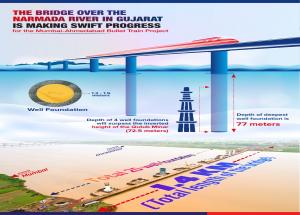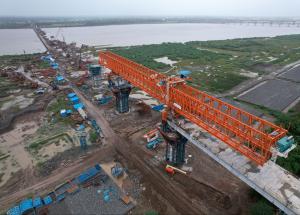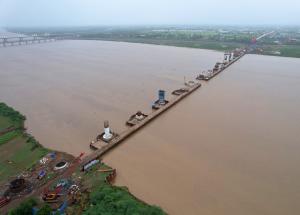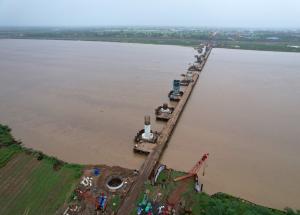Depth of 4 well foundations will surpass the inverted height of the Qutub Minar
The Mumbai-Ahmedabad Bullet Train corridor will pass over the Narmada River in the state of Gujarat. The Narmada River, often referred to as the "Life Line of Madhya Pradesh and Gujarat," flows through central India, is deeply significant both culturally and geographically. The river is crucial for water resources, supporting agriculture, drinking water, and hydropower. The Narmada River, with its blend of spirituality, history, and economic importance, continues to play a vital role in the lives of millions. The third highest concrete dam in India- The Sardar Sarover dam is also on this river which is 1210 meters (3970 feet) in length and the maximum height of the dam is 163 meters above the deepest foundation level.
A 1.4 km long bridge on the Narmada river for the Bullet Train project in Bharuch district, Gujarat (in between Surat and Bharuch Bullet Train stations) is under construction. This is the longest river bridge in the Gujarat portion of the project.
The bridge is being constructed on well foundations. A well foundation is a type of deep foundation situated in rivers used to support heavy structures such as bridges. It consists of a hollow, cylindrical structure that is sunk into the ground to a desired depth to provide stability and load-bearing capacity. Well foundations are one of the oldest and most effective foundation types for railways, highways, bridges/viaducts over wide rivers. This method is often used in areas with deep and unstable river beds where other foundation types are not feasible.
The Narmada HSR bridge consists of 25 nos. of well foundations. Five (05) nos. of wells are more than 70 meters deep and the deepest well foundation (well cap top to founding level of well) in Narmada River is 77.11 meters, and the depth of other well foundations in the river is around 60 meters. 4 nos. of well foundations will surpass the inverted height of the Qutub Minar, one of the tallest structures in India (height of the Qutub Minar is 72.5 m, Source: Delhi Tourism).
The major challenge associated with well foundation structures is the “Tilt” and “Shift” of wells during the long duration sinking process because of natural forces such as tidal waves, high river flow, and soil conditions at the sinking level.
The construction of bridge over mighty river Narmada was affected adversely during monsoon season and flood situation in September 2023. A large quantity of water (approx.18 lakh cusec) was released from Sardar Sarovar dam, resulting in damage to temporary steel bridge to facilitate construction, submergence & malfunctioning of on-site heavy-duty cranes, making work-fronts inaccessible and disturbance to electrical connectivity.
Despite these challenges, the site engineers worked tirelessly day and night to restore the operations. Additional teams were mobilized to continuously monitor the sinking of wells. With the use of Jack-Down method, the tilt and shift issues were addressed well in time.
With meticulous planning and dedicated on-site team, the bridge work has achieved remarkable progress with completion of 19 foundations out of 25 wells. The work of erection of superstructure has also commenced.
Salient features of the bridge:
- Total spans: 24 nos. (21X60m + 2X36m + 1X35m)
- Nos. & size of well foundations: 25 nos. (10m dia. & more than 60 m deep)
- Total number of Piers: 25 circular piers (5m & 4m dia.)
- Height of the Piers: 14 m to 18 m
- Type of superstructure: Post-Tensioned Box girders (SBS type)
There are total 24 river bridges in the project, 20 are in Gujarat and 4 in Maharashtra. Out of 20 bridges in Gujarat, ten (10) have been completed on rivers: Par (320 m) Valsad district, Purna (360 m) Navsari district, Mindhola (240 m) Navsari district, Ambika (200 m) Navsari district, Auranga (320 m) Valsad district, Venganiya (200 m) Navsari district, Mohar (160 m) Kheda district, Dhadhar (120 m) Vadodara district, Kolak River (160 m) Valsad district and Vatrak (280 m), Kheda district.






